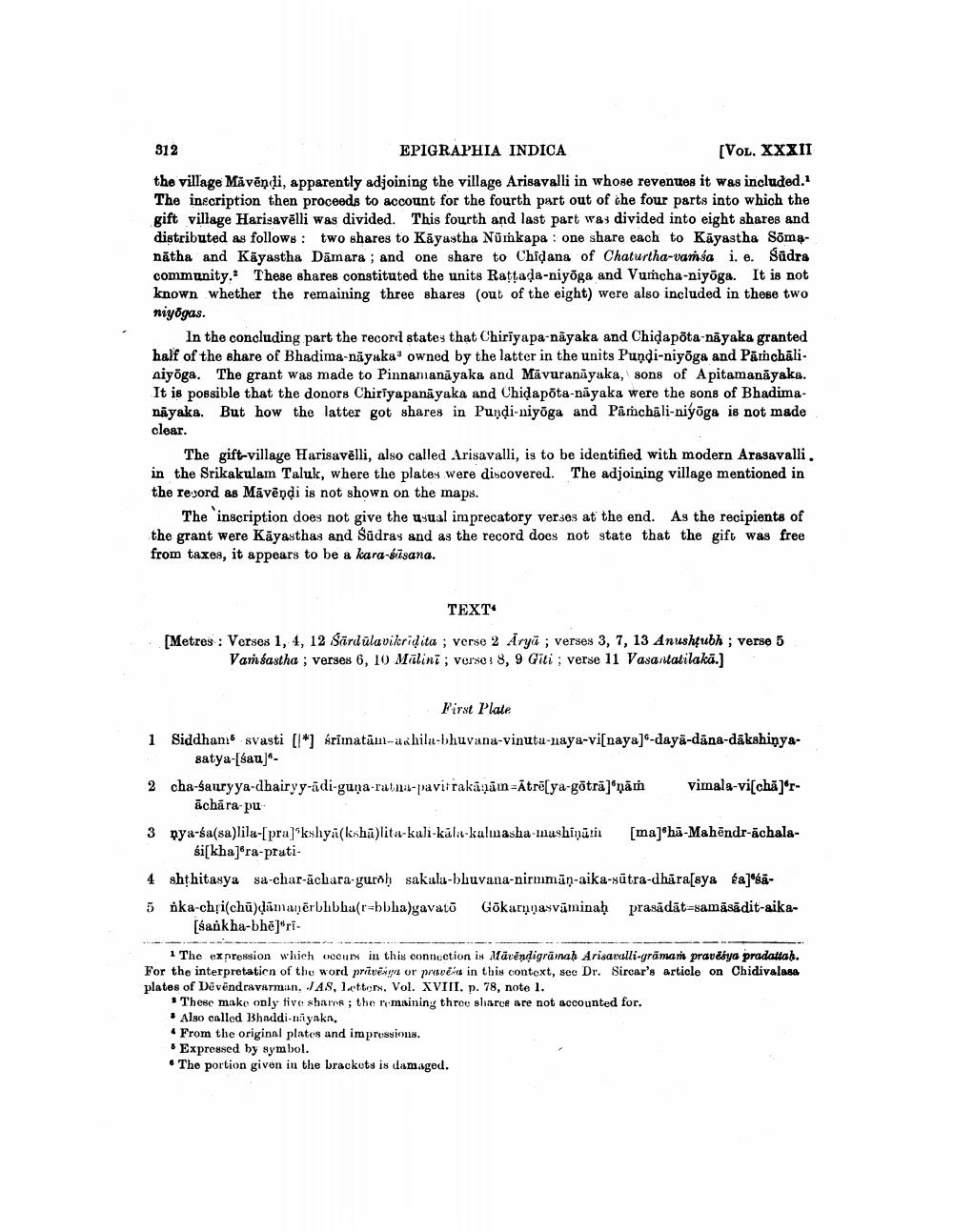________________
312 EPIGRAPHIA INDICA
[VOL. XXXII the village Măvēndi, apparently adjoining the village Arisavalli in whose revenues it was included. The inscription then proceeds to account for the fourth part out of the four parts into which the gift village Harisavēlli was divided. This fourth and last part was divided into eight shares and distributed as follows: two shares to Kāyastha Nūmkapa : one share each to Kāyastha Somanātha and Kāyastha Dāmara ; and one share to Chidana of Chaturtha-vaṁsa i. e. Sūdra community. These shares constituted the units Rattada-niyoga and Vumcha-niyoga. It is not known whether the remaining three shares (out of the eight) were also included in these two niyogas.
In the concluding part the record states that Chirīyapa-nāyaka and Chidapõta-nāyaka granted half of the share of Bhadima-nãyuka' owned by the latter in the units Pundi-niyoga and Pärchāli. niyoga. The grant was made to Pinnamanāyaka and Māvuranāyaka, sons of A pitamanāyaka. It is possible that the donors Chiriyapanāyaka and Chidapōta-nāyaka were the sons of Bhadimanāyaka. But how the latter got shares in Pundi-niyoga and Pāmchali-niyoga is not made
clear.
The gift-village Harisavēlli, also called Arisavalli, is to be identified with modern Arasavalli. in the Srikakulam Taluk, where the plates were discovered. The adjoining village mentioned in the resord as Māvēndi is not shown on the maps.
The inscription does not give the usual imprecatory verses at the end. As the recipients of the grant were Kāyasthas and Sūdras and as the record does not state that the gift was free from taxes, it appears to be a kara-būsana.
TEXT
[Metres : Verses 1, 4, 12 Sārdūlavikridita ; verse 2 Arya ; verses 3, 7, 13 Anushțubh ; verse 5
Vamsastha ; verses 6, 10 Malini ; verse: 8, 9 Giti ; verse 11 Vasantatilakā.]
First Plate 1 Siddhan svasti [l*] krimatām-achila-bhuvana-vinuta-naya-vi[naya)-dayā-dana-dākshinya
satya-(sau)* 2 cha-Sauryya-dhairyy-ādi-guņa-ratna-pavitrakāņām=Ātrē[ya-gātrā]*ņām
trakānām Ātrē[ya-gotrā]øņām vimala-vischă]ørachāra-pu 3 pya-sa(sa)lila-[pra]“kshyakshā)lita-kali-kali-kalmasha-mashinūti [ma]"hā-Mahēndr-achala
si[kha]era-prati4 shthitasya sa-char-āchara-gurõh sakala-bhuvana-nirmmāņ-aika-sūtra-dhāra[sya kalsa5 nka-chți(chū)dāmaņērbhbha(r=bbha)yavato Gokarunasvāminaḥ prasādāt=samāsādit-aika
[sankha-bhējøri
1 The expression which occurs in this connection is Māvēndigrāmah Arisavalli-grāman pravēšyo pradattah. For the interpretation of the word privēxt or pravēša in this context, see Dr. Sircar's article on Chidivalasa plates of Devendravarman, J48, Letters, Vol. XVIII. p. 78, note 1.
• These make only five sharre; the maining three share are not accounted for. • Also called Bhaddi-nayakn.
From the original plates and impressions. * Expressed by symbol. • The portion given in the brackets is damaged.




